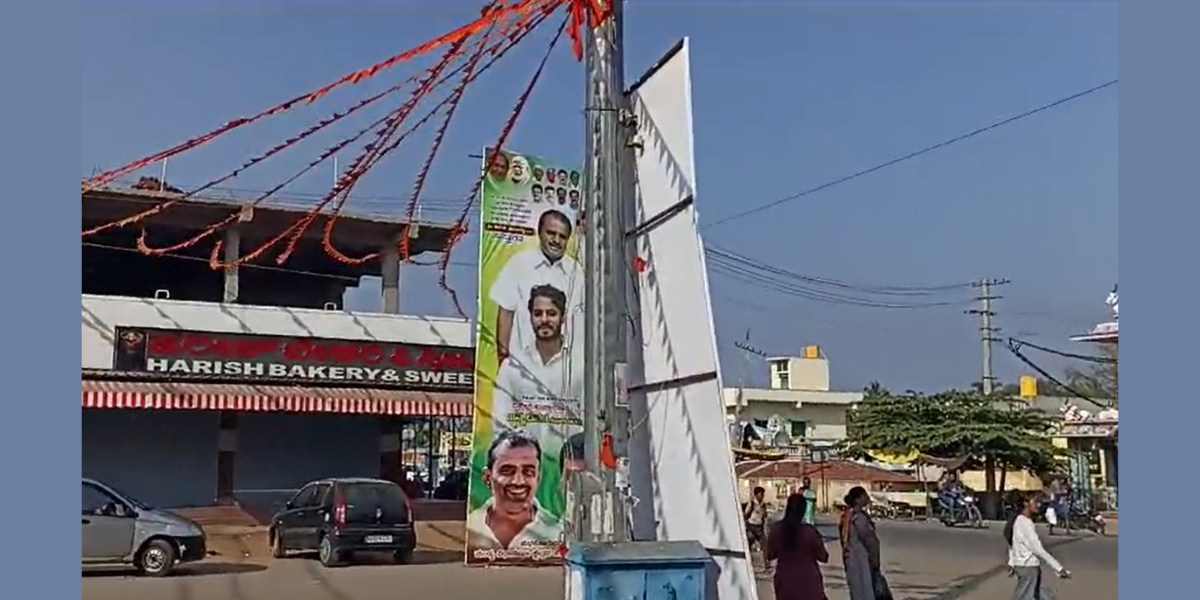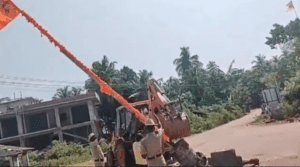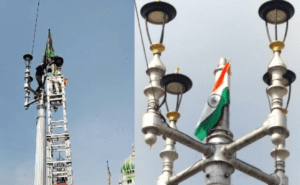The Mandya protest has had a ripple effect in various locales, unveiling additional chapters of tension and protest across different regions.

Banners in Keragodu village. (South First)
On the heels of a massive protest by the BJP, JD(S), and Bajrang Dal activists — that began in Mandya district and spread statewide — over the removal of a hoisted Hanuman flag in Keragodu village, the Mandya district administration issued a directive to the police to remove all banners installed in public places in the district, including those of political parties.
In Keragodu, although Gram Panchayat president Naveen Kumar TS and other panchayat office-bearers issued instructions on the removal of banners, a majority of the villagers — primarily JD(S) loyalists — requested authorities not to use earthmovers to remove them but instead give them a chance to remove them safely and store them in the panchayat’s godown.
However, the villagers do not intend to wave a white flag just yet.
A majority of the villagers, along with the members of the Gowrishankar Trust, held a discussion on Wednesday, 31 January, and decided that they would ensure that at least one Hanuman flag is hoisted at every house, shop, or plot of land in Keragodu village from 2 February.
“This move was decided by all of us as there has been no response to the memorandum submitted (on Monday) to the District Commissioner’s office in Mandya. The government’s message is clear. Only the national flag and state flag will be hoisted on the brand new high-mast pole,” KL Krishna, a former panchayat member told South First.
The protest that began in one small village has had quite a ripple effect in various locales, unveiling additional chapters of tension and protest across different regions.
In Bhatkal, the Muslim-dominated town in Coastal Karnataka, a sudden protest erupted on Tuesday, led by about a dozen BJP workers and a couple of youths affiliated with Sangh Parivar organisations.

The flag pole at Bhatkal’s Tenginagundi port was removed on 27 January. (South First)
The protest, held in front of the Gram Panchayat office in Bhatkal town, was against the removal of a flagpole at the Tenginagundi port where a saffron flag had been hoisted. Earlier, a few BJP workers had erected a stone pillar at the port that they named Veer Savarkar and had hoisted a saffron flag on it on the night of 21 January to celebrate the consecration of the Ram temple at Ayodhya that was scheduled for the next day.
Initially, the presence of the saffron flag at the port was tolerated by Muslim traders, but complaints arose in the subsequent days. The Gram Panchayat ordered the removal of the flag post on 27 January, leading to protests by the BJP and Sangh Parivar workers.
Drawing inspiration from the Keragodu incident, they protested against the panchayat’s decision, arguing that a similar fate awaited Tenginagundi port.
Despite the authorities maintaining that the port was not a suitable place for a flagpole, BJP workers and Sangh Parivar members have vowed to escalate their protest.

Shivajiinagar’s Chandni-Chowk styled streetlamp. (South First)
At the busy Russel Market junction in Shivajinagar, Bengaluru, stands a Chandni-Chowk styled streetlamp in the centre of the road, likely erected during the British era and maintained by the Bruhat Bengaluru Mahanagara Palike (BBMP).
A nearby Dargah, named Jamil Shah Dargah, had been hoisting a green-coloured Dargah flag for years. This was being done even during the BJP regime and no one had any problem, the Shivajinagar police told South First.
However, after the Keragodu flag row, on 30 January, a passerby took a photograph of the streetlight and questioned on social media why a green-coloured flag was allowed to be hoisted in the city centre when a Hanuman flag was taken down in Mandya. This post, tagged to BJP leaders like Basangouda Ramangouda Patil Yatnal and the Bengaluru City Police Commissioner, gained traction online.
In response, the police and BBMP authorities visited the Dargah, where the priest assured them that they would voluntarily remove the flag and hoist a Tricolor instead. “They did what they said they would do immediately and also told us that they would not want to rake up any controversy,” said a senior police officer with the Shivajinagar Police Station.
ಶಿವಾಜಿನಗರದ ಚಾಂದಿನಿ ಚೌಕ್ನ ಹೈ-ಮಾಸ್ಕ್ ವಿದ್ಯುತ್ ಕಂಬದ ಮೇಲೆ ಹಾಕಿದ್ದ ಹಸಿರು ಧ್ವಜವನ್ನು ತೆರವುಗೊಳಿಸಿ, ಅಲ್ಲಿ ತ್ರಿವರ್ಣ ಧ್ವಜವನ್ನು ಹಾರಿಸಲಾಗಿದೆ
ಜೈ ಹಿಂದ್ ! pic.twitter.com/A6tNwH20uC— Basanagouda R Patil (Yatnal) (ಮೋದಿಯವರ ಕುಟುಂಬ) (@BasanagoudaBJP) January 30, 2024
In Dharwad’s Tadkod village, a couple of families from the minority community opted to stay away from home and instead stay with relatives temporarily, after receiving warnings from pro-Hindu activists.
This decision was made in the wake of a youth from the minority community posting a controversial picture on social media on 21 January. Despite the police arresting the youth for inciting religious enmity, pro-Hindu activists vandalised the youth’s house on the nights of 24 and 25 January, threatening to return on 30 January.
Superintendent of Police Gopal M Byakod told South First that the Dharwad police has registered two cases of rioting, criminal intimidation, trespass, and also property damage, and had arrested 14 individuals.
“However, two to three families — relatives of the accused Muslim youth — decided to leave for a couple of days as they did not want to be present at their houses, fearing it would unnecessarily instigate the pro-Hindu activists who said that they would be coming back to check on them,” a community elder, who wished to remain anonymous, told South First.
Upon learning of the situation, SP Byakod, along with his subordinates, conducted a peace meeting with villagers in Tadkod on 31 January.
Amidst these off-shoot incidents, the echoes of dissent and the quest for identity continue to reverberate, leaving behind a mosaic of challenges that transcend the boundaries of a single village or town.

May 03, 2024

May 03, 2024

May 03, 2024

May 03, 2024

May 03, 2024

May 03, 2024